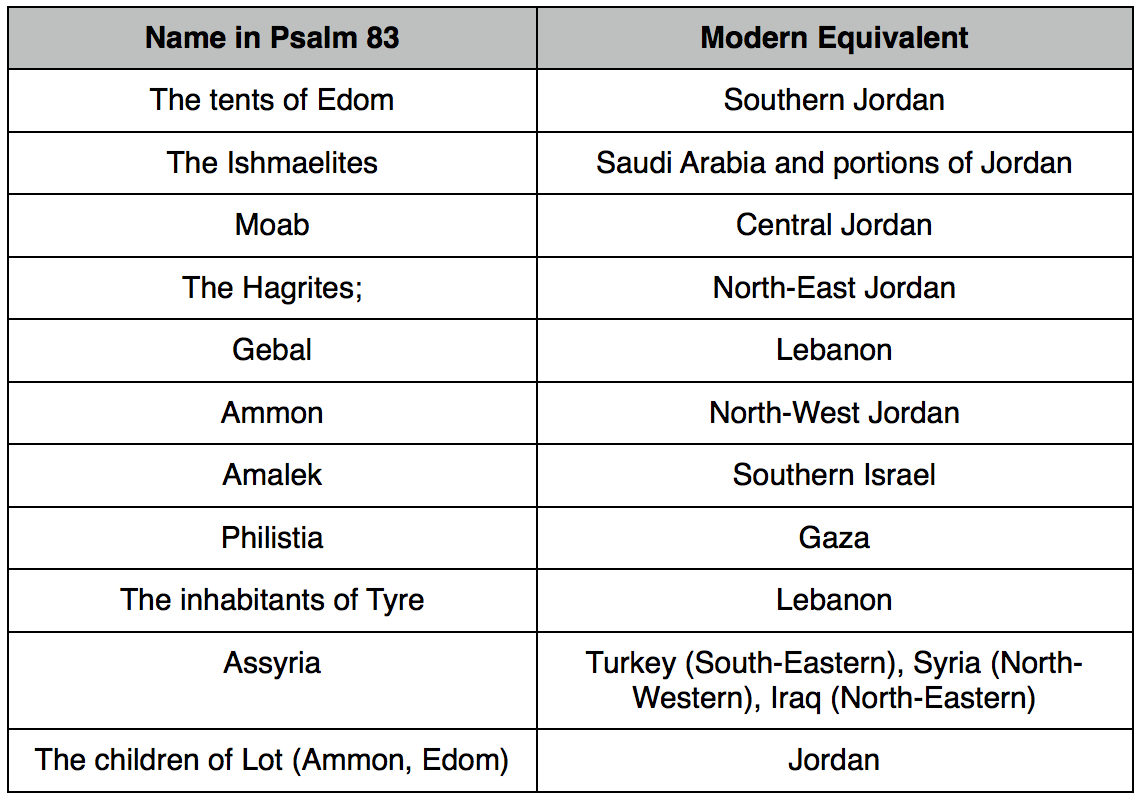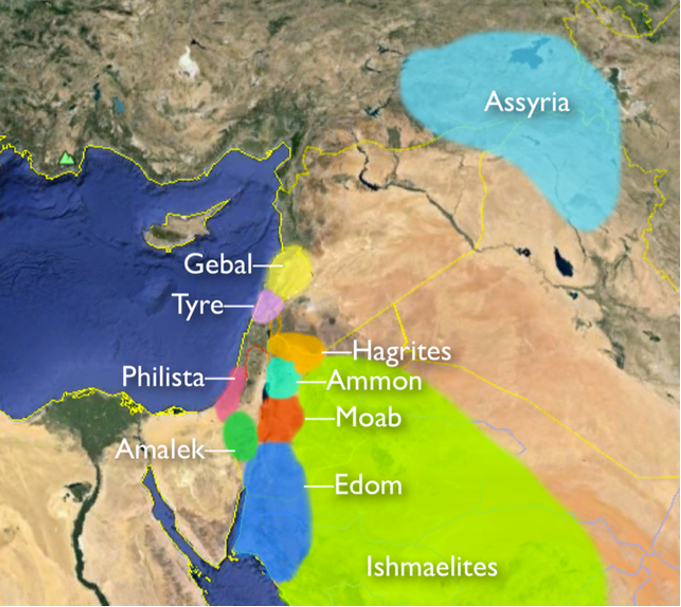John 18:1-18
2 Chronicles 26
Psalm 83
 |
| Listen to the Bible |
Thoughts and Commentary on Today's Reading
Psalm 83 is a prophetic Psalm. Many say that it describes Armageddon. Some believe that Psalm 83 is about the conflict of Gog and Magog, occurring separately from Armageddon.Joel Richardson has written numerous books about the coming Antichrist power. Certainly, we don't agree on everything (for example, Richardson teaches that Christ will have a Millennial reign on earth - which we don't agree with), but he has much to teach that bears study - especially his assertion that the final antichrist will be a Muslim. Consider the following commentary on Psalm 83 by Joel Richardson. If nothing else, it forms an excellent diving board for jumping deeper into the study of this prophetic chapter.
Those who teach that Psalm 83 is to be understood as a specific war, distinct from the Battle of Gog of Magog, or other wars of the Antichrist, base their view on a series of inferences and assumptions. We need to understand what these assumptions are.
First, proponents of this view point out that the nations listed in Psalm 83 are not listed in Ezekiel 38-39. Despite the fact that this is not entirely true (both passages include Turkey), it is from this observation that the first assumption is made that these passages must be speaking of two separate wars or battles.
Then it is observed that the nations listed in Psalm 83 are close to Israel, forming what is often called an “inner ring” of nations, whereas the nations mentioned in Ezekiel 38 and 39 form a larger “outer ring” of nations. So the second assumption is that in the future, Israel will first utterly defeat, even annihilate and occupy, the “inner ring” nations, and then at a later time, engage the “outer ring” of nations in war.
Before we turn to the Scriptures to examine the problems with this theory, it is important to stop and consider exactly what is being proposed by those who teach this theory. One teacher, for example holds that the nations of Egypt, Saudi Arabia, Iraq, Jordan, Syria, and Lebanon will all be defeated and occupied by Israel:
“Because of this Israeli conquest over the inner circle of the core surrounding Arab populations of Palestinians, Syrians, Saudi Arabians, Egyptians, Lebanese, and Jordanians, Israel’s borders are enlarged, prosperity increases, and national stature is enhanced.” (Israelestine: The Ancient Blueprints of the Future Middle East, Bill Salus)Other prophecy teachers, seem to differ slightly from this view, teaching that these nations will all simply be “annihilated” by Israel, in what is referred to as “The War of Extermination”.
In my opinion, both positions strain the bounds of believability on a few levels. The idea that Israel, a single nation with approximately 6 million Jews, will either subdue and concurrently occupy, or worse yet, “annihilate” several nations with a total population of approximately 170 million Arabs is quite a claim...
But let us turn to the primary reason why the popular Psalm 83 War of Extermination theory stands in direct conflict with Scripture. Before we do however, it is necessary to identify which nations are mentioned in Psalm 83. The following chart lists the names of the nations and people as they appear in Psalm 83 as well as their modern equivalents:
The nations and peoples of Psalm 83
The nations and peoples of Psalm 83
Egypt?
It is important to take note of the fact that the nation of Egypt is not included among the nations listed in Psalm 83. While some have made the claim that the Hagrites correlate to Egypt, this is simply not accurate. When Psalm 83 was written, Egypt was a well known nation. If the Psalmist had intended Egypt to be included among his list of nations, he would simply have listed Egypt. Instead he listed the Hagrites along with the other nation-tribes that occupied the region that makes up modern day Jordan. During the life of Asaph, the author of this Psalm, in the 10th century B.C., the Hagarites were a people who lived in the region of northern Jordan, east of Gilead. Of this, the Scriptures are clear:
“In the days of Saul, they (the tribe of Rueben) made war with the Hagarites, who fell by their hand: and they dwelt in their tents throughout all the east land of Gilead.” —1 Chronicles 5:10When do the Psalm 83 nations meet their judgment?
The simplest way to demonstrate that the nations of Psalm 83 are not destroyed in a war several years before the Return of (the true Christ), is to examine when the Bible states that these regions will be judged and defeated. As we will see, every name, nation, or region listed in Psalm 83 is specifically mentioned numerous times throughout the prophets as being judged and defeated by (Yahshua, in the End). Lets consider just a few examples from Scripture.
Edom and Moab
The first of the conspirators in Psalm 83 is Edom. Edom refers to the region of southern Jordan and northwestern Saudi Arabia. Moab was Edom’s neighbor just to the North in what is today, central Jordan (see map). There are numerous prophetic passages that portray the ultimate judgment of these peoples and regions in the context of the Return of (Christ).
Numbers 24:17-19
Lets begin with Numbers 24:17-19, a prophecy that speaks of the coming King Messiah:
“I see Him, but not now; I behold Him, but not near; a star shall come forth from Jacob, a scepter shall rise from Israel.”Bible scholars believe this prophecy was among those that were looked to by the Magi in their effort to seek out the Messiah, the King of Israel, the account of which is recorded in the Gospels. But according to the prophecy, who will the King Messiah defeat when he arrives? According to the text, it is both Moab and Edom:
“He shall crush through the forehead of Moab, and tear down all the sons of Sheth. Edom shall be a possession.”The crushing of the heads of Israel’s enemies here is actually an expansion of the proto-evangelic prophecy in Genesis 3:15 wherein the Messiah is predicted to ultimately crush the head of Satan. But here, that victory of the Messiah over Satan and his seed is expanded upon and actual names are given to identify the seed of the serpent. Thus Edom and Moab are the peoples identified.
While proponents of the Psalm 83 War theory claim that Edom and Moab will be utterly annihilated by the Israeli Defense Forces several years before the return of Jesus, the Scriptures tell us that this will be carried out by Jesus when He returns. Why would (Yahshua) need to engage in war and judgment with a people who were annihilated only several years prior?
Isaiah 34, 66
Edom is also judged most clearly by (Yahshua) in Isaiah 34 and 66. Together these two passages form a graphic prophetic picture of the judgment of Edom personally carried out by (Yahshua - at the End). The entire chapter of Isaiah 34 is a poetic portrayal... (Yahweh’s) Wrath is executed against the people of Edom specifically because of their unjust treatment of Israel:
For My sword has drunk its fill in the heavens; behold, it descends for judgment upon Edom, upon the people I have devoted to destruction. Yahweh has a sword; it is sated with blood; it is gorged with fat, with the blood of lambs and goats, with the fat of the kidneys of rams. For Yahweh has a sacrifice in Bozrah, a great slaughter in the land of Edom . . . Their land shall drink its fill of blood, and their soil shall be gorged with fat. For the lord has a day of vengeance, a year of recompense for the cause of Zion. And the streams of Edom shall be turned into pitch, and her soil into sulfur; her land shall become burning pitch. (vv. 5–9)The context is the Day of (Yahweh), the Day of His vengeance. It occurs when (Yahshua) returns. The people of Edom are destroyed specifically as a just recompense for the “cause of Zion”. Later, in Isaiah 63, the same event is described again in very graphic detail:
Who is this who comes from Edom, in crimsoned garments from Bozrah, he who is splendid in his apparel, marching in the greatness of his strength? “It is I, speaking in righteousness, mighty to save.” Why is your apparel red, and your garments like his who treads in the winepress? “I have trodden the winepress alone, and from the peoples no one was with me; I trod them in my anger and trampled them in my wrath; their lifeblood spattered on my garments, and stained all my apparel. For the Day of Vengeance was in my heart, and my year of redemption had come.” (vv. 1–4)In this highly dramatic passage, Isaiah the prophet is looking south-eastward from Jerusalem. In his mind’s eye, he sees a majestic and determined Figure—it is (Yahshua) the Messiah—marching victoriously... out of Edom and Bozrah. Bozrah was the capital city of ancient Edom. Today it is called Petra. Once more, the timing is the Day of (Yahweh's) Vengeance, and (Yahshua) Himself is clearly... personally executing the justice...
If anyone would still question whether or not Isaiah 63 and 34 are speaking of the return of (Yahshua), all doubt is put to rest when we see that the quintessential passage concerning the return of (Yahshua)—Revelation 19—finds the theme of (Christ) treading “the winepress of the fury of the Wrath of God the Almighty” directly from Isaiah 63.
The two passages are both speaking of the Return of (Yahshua) as He executes Vengeance against His enemies. The armies of the Beast in Revelation 19 are identified as Edom in Isaiah 63. In both passages, (Yahshua) crushes His enemies.



